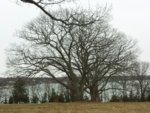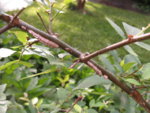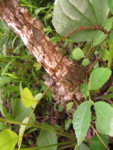It's quite likely I have the ID wrong. There are a couple bits that look like old wings on the secondary trunks. I meant to get a picture this morning but got side-tracked and will do it tonight. They may be a fungus, but I haven't seen mushrooms growing in a vertical line. From what I've seen of winged elm's wings, they seem to appear on strong growing twigs, but this tree hasn't really pushed strong growth and all the early leaves were damaged. We have had a very wet, cool spring and this tree is in really crappy soil, so there seemed to be some fungal issues in the leaves. Also, I think the bark looks dark because it's dirty, so I will have to give it a spray and scrub. It's still fairly smooth, but probably not as dark as the picture suggests. Anyway, if it's not a winged elm, what are the other likely options for species? I may just need to get it growing healthy to see what the hardened leaves and the stems look like. Either way, I have until October to figure out how much winter protection it needs. Thank you all for your input!


























